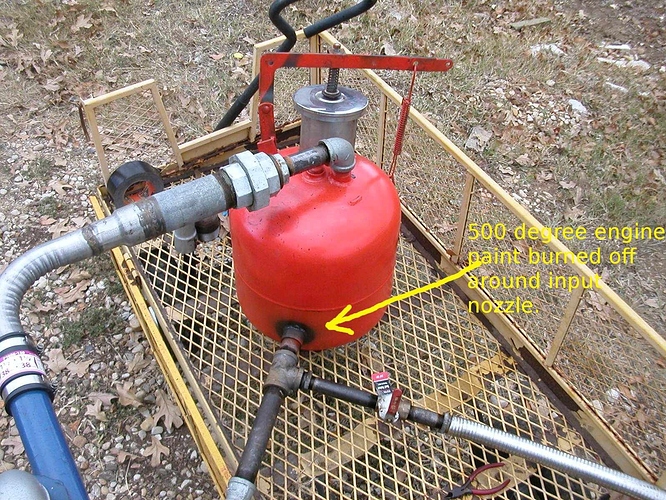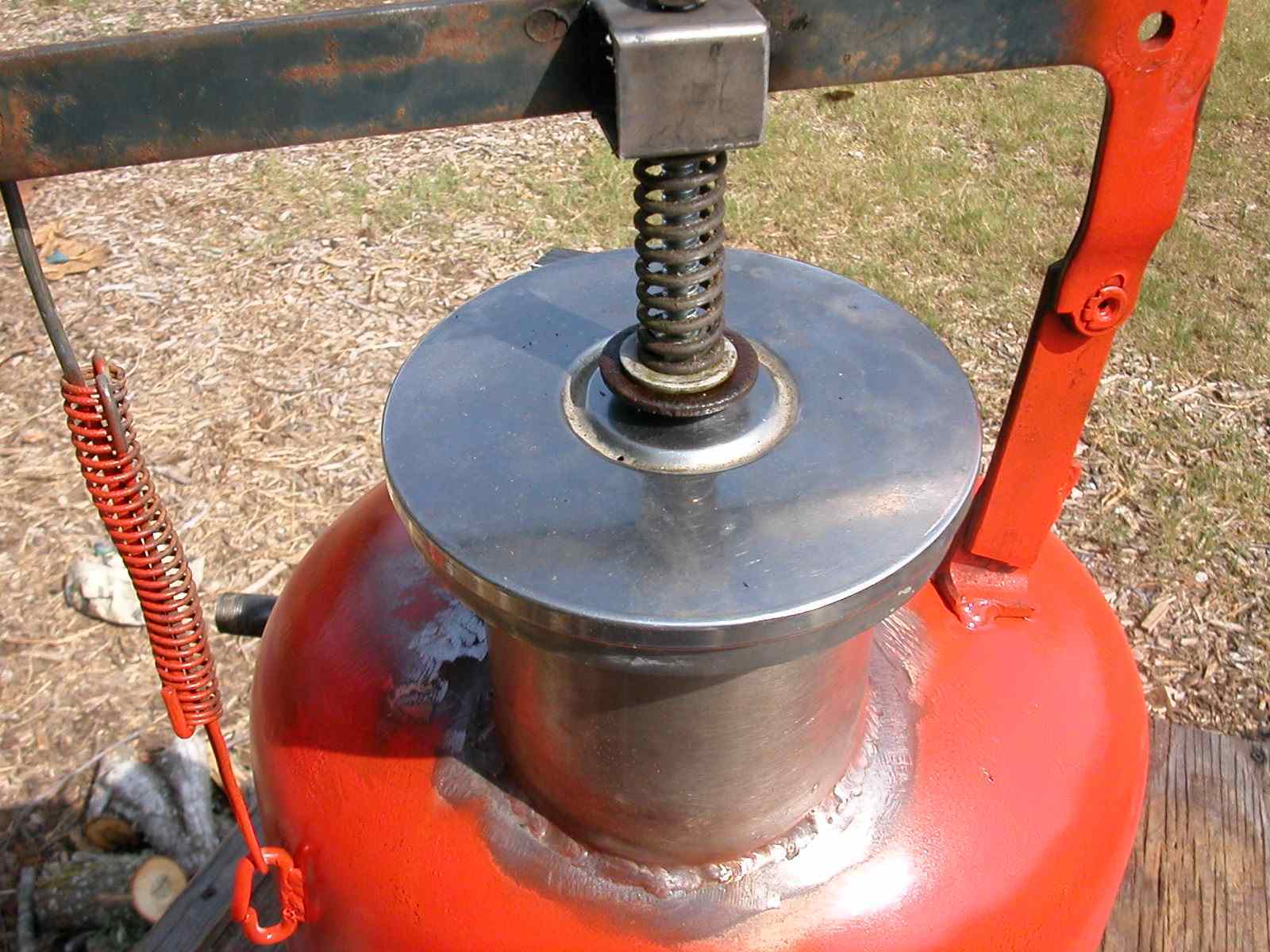Koen, how do you calculate nozzle size requirements? If you have a smaller nozzle the air blast velocity would be higher and would that serve to keep the nozzle cleaner and the hot incandescent core further from the nozzle?
I have decided to build a simple fire to run a medium sized generator.
Right now, my plan is to use a grease drum (20 gal I think ?) for the reactor.
I have one question about the design.
I notice that nozzle erosion is an ongoing concern.
I also notice that exhaust gas is used slow down the reaction.
I was wondering what would happen if the exhaust gas was introduced via a shroud around the nozzle rather than directly into the main nozzle air stream. My idea is that the exhaust gas would create an annular “gas blanket” around the nozzle tip, thereby protecting it from rapid oxidation.
In other words, what I am envisioning is the nozzle (a 1" pipe) surrounded by a slightly bigger, and slightly shorter pipe, with the exhaust gas being introduced into the space between the two pipes, and flowing out around the end of the nozzle pipe.
I like your thinking, but I’m skeptical that it would work.
From what I’ve been reading, there is very little O2 on the outside of the nozzle pipe since the hot carbon almost instantly binds with it.
There is however, lots of oxygen on the inside of the pipe in the airflow (obviously) which is in contact with the hot pipe walls.
Hi Kyle, I’m leaning towards a nozzle that points up from below with a layer of refractive or refractive brick. As it burns it forms a sort of volcano slag cone. It seals at shut down so you poke a metal bar through it at start up and keep going. Sort of like a perpetually regenerating nozzle. I hate the idea of being tied to consumables. I can’t prove that yet but my tractor has over 20 hours on it with that setup and still works fine I’ll know for sure son as I have to dis mantle the tractor and gasifter soon. …
Best regards David Baillie
Someone on here did something similar a while back, but I don’t remember who, and I don’t think we really found out if it worked or not. I’m thinking “tuyere-less charcoal gasifier” or something.
I recall that they removed the valve stem from a moderate sized propane tank, cut a door in the bottom of the tank, pounded a wooden dowel into/through the valve stem bung, turned the entire thing upside-down, and poured in an inch or 2 thick layer of refractory into the bottom (formerly the top of the tank) around the dowel.
Once everything is set, the dowel was removed, leaving a hole in the refractory, much like a magma vent under a volcano.
I found the link (super easy) Tuyere-less charcoal gassers it looks like it was @Jeff who made this, and luckily he’s still around here, unlike a few too many creative souls.
My brother has 20+ hours on his 8 hp lawn tractor with no problems. The nozzle is a piece of 2-1/2" thick firebrick with a hole bored through it. Enough exhaust gas added to just see the shape of the charcoal pieces.
I have a smaller charcoal gasifier that uses the bottom air feed with a layer of refractory cement in the bottom and a small tig nozzle for good measure , but I don’t have a lot of luck getting really good strong gas out of it , and because I don’t use exhaust return to cool it down I found getting steam or water to it a lot harder .
The old unit that has the nozzle into the side about 2 inches from the bottom works brilliant for my stationary engines as I can see what is happening as I drip water and watch it turn to steam and get sucked in and adjust the drip to the colour of the coals , the nozzle that’s inside this unit at the moment is the old one from last winter and has seen maybe 3 months of use so far with a running time of approx. 5 hours at a time maybe 4 days a week depending on how cloudy its been .
So for me I go with a number 15 tig nozzle with a 1 inch pipe resting on top of it and then covered in refractory cement with about an inch of pipe sticking out the end that I plug into my adapter on the side of the tank .
Dave
Dave, does the nozzle have a coke volcano forming around it or slag deposit forming around it that plugs up the nozzle opening or restrict it at times. Max Gasman talks about this but he is also using wood in his gasifier with 8 nozzles I think.
Bob
Kyle ,sounds like an idea that should be tried. That might be just enough to slow down the erosion of the nozzle end. If it doesn’t help, you are not out anything, just a little added complexity.
Brian, two weeks ago I casted one with a plastic discarded vitamin bottle. I have a water pan below that for humid air plus heat exchange fins. When the volcano builds up too much I remove the grate and poke it out with a stick.
Thanks Koen
Your description really helps.
What is a safe distance from the bottom of the container to the nozzle?
Kyle, on my build that’s what I’m doing, what you are talking about. Exhaust and air will flowing out of my 2" tuyere and around my nozzle. Inside my nozzle with a 1 1/8" flair from a 1/2" pipe will also have exhaust and air coming thought it. My nozzle can change out to a 3/4" or 1". So exhaust will be flowing around the out side and inside of the nozzle. Mine is not a simple fire setup though. It would be easy to make with plumbing parts for a simple fire just scale it down.
Bob
Koen,
On the last photos you sent here, why vitrified ash is not around the nozzle?
Why vitrified ash clog the nozzle?
Thierry
Hi Thierry,
The bamboo is containing a lot of silica, the picture comes from an overpull for testing capacity.
Its all experimenting and analyzing…
My feeling is that the glowing “candle” was already at its max, then the overpull gave it the oxygen to reach the vitrifying temperature.
I am a stubern student, so its going to take ages before i start listening to others 
Hi Don,
Soon as i get more time to sit behind the comp, i will find the calculation sheet i made and forward this to you.
I try to get my numbers as close to the data from the book “crossdraft”
But it seems that a simple fire will always work…
When i poke my air inlet, with a welding rod, then i see a nice glowing patern on the wire, about 2-3" big, just in front of my nozzle…
This is also the same spot where i generate my “lava” , with the rod i can pull that molten stuff out 
If i leave the rod in, it melts away rather quick… 
experimenting is fun…
I just finished making a couple of spare nozzles using castable refractory, #15 TIG cup, and a 1" pipe nipple cut in half. A roll of thin cardboard holds the steel and the TIG cup together while the cement in tamped into a tomato soup and rotella cans. Here are some photos:
I’ll be putting these in a plastic bag and let them cure until needed. The whole thing (can and all) will be threaded into my nozzle adapter in the bottom side of the Simple-Fire.
Ray
Nice Ray! Have you used these before? Do you use them horizontally or vertically ?
Hi Ray ,
Looking good there , did you use a shop bought refractory or is it a home made recipe you made up ? The refractory I used was almost white when I cast it into my tin with tiny bits of pink Alumina mixed into it .
Dave
Jim, I use it horizontally in a propane tank with a Bain Marie as a hopper. At first I used the plain nipple wrapped in stainless sheet stock. Then I changed that to a ceramic coffee mug with a 1" hole cut in the bottom. That is the one that caused the high temperature paint to burn on this picture. Instead of going out the hole in the mug, the air was backing up to where the open end of the mug was against the tank.
I solved that problem by wrapping the steel pipe covered with the stainless with high temperature ceramic wool cloth and stuffed the whole works into the ceramic mug and screwed it into the fitting inside the tank. That worked, but last time I dumped out the charcoal and cleaned the slag off the end of the mug at the exit hole, I cracked the mug. (Put a stainless hose clamp around it, and put it back into the gasifier.)
The hopper on this was a stainless steel Bain Marie which I TIG welded into the top of the propane tank to be able to quickly add more charcoal.
The lid on the top is a top from an old electric percolator coffee pot. The gasket is a piece of silicon baking sheet. (I also used a mouse pad.)
The arm that holds the lid down is from an old recliner. This was all written up on the Yahoo Charcoal Gasifier Group moderated by Gary Gilmore. (No postings in a very long time on that group. Everything is on DOW.)
I haven’t used these before because I recently bit the bullet and bought a bucket of refractory cement from Amazon.com. I’m hoping that the 2200 degree stuff isn’t going to immediately melt into a blob. I suppose I could wrap it in the high temperature ceramic wool stuff…I bought a large box of it and split it with Martin Payne.

